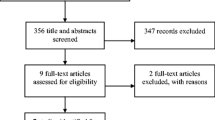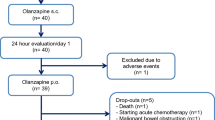Abstract
Purpose
The primary aim of this study was to clarify the effect of sublingual scopolamine on the intensity of nausea.
Patients and methods
This was an open uncontrolled study, and the study participants were cancer patients consecutively admitted to a palliative care unit in Japan. When the patients had nausea, they were administered a solution of scopolamine at 0.15 mg sublingually. The intensities of nausea were assessed using the 6-point Numerical Rating Scale (NRS 0 = no nausea to 5 = worst nausea) before and 15, 30, and 60 min after administration. Primary endpoints were (1) changes in the NRS of nausea and (2) percentage of patients who achieved a decrease in NRS of 1 or more points 15 min after treatment.
Results
Twenty-six patients were recruited for this study. The median NRS significantly decreased from 3.0 (range, 1–5) to 1.5 (0–5) after 15 min, and 84 % (n = 21) of the patients achieved a decrease in NRS of 1 or more points after 15 min. In addition, the median NRS significantly decreased from 3.0 (before) to 0 (30 min) and 0 (60 min). The percentage of patients who achieved a decrease in NRS over 1 point was 96 % (n = 25) in 30 min and 100 % (n = 26) in 60 min. Fifteen percent (n = 4) showed drowsiness. No other adverse effects were reported.
Conclusion
Sublingually administered scopolamine may be effective for managing nausea in terminally ill cancer patients. Randomized controlled trials are promising.
Similar content being viewed by others
References
Davis MP, Walsh D (2000) Treatment of nausea and vomiting in advanced cancer. Support Care Cancer 8:444–452
Davis MP, Hallerberg G (2010) A systematic review of the treatment of nausea and/or vomiting in cancer unrelated to chemotherapy or radiation. J Pain Symptom Manage 39:756–767
Bentley A, Boyd K (2001) Use of clinical pictures in the management of nausea and vomiting: a prospective audit. Palliat Med 15:247–253
Lichter I (1993) Results of anti-emetic management in terminal illness. J Palliat Care 9:19–21
Bruera E, Belzile M, Neumann C et al (2000) A double-blind, crossover study of controlled-release metoclopramide and placebo for the chronic nausea and dyspepsia of advanced cancer. J Pain Symptom Manage 19:427–435
Bruera E, MacEachern TJ, Spachynski KA et al (1994) Comparison of the efficacy, safety, and pharmacokinetics of controlled release and immediate release metoclopramide for the management of chronic nausea in patients with advanced cancer. Cancer 74:3204–3211
Mystakidou K, Befon S, Liossi C et al (1998) Comparison of the efficacy and safety of tropisetron, metoclopramide, and chlorpromazine in the treatment of emesis associated with far advanced cancer. Cancer 83:1214–1223
Oscar C, Arianna C, Luigi B (1995) Effectiveness of levosulpiride versus metoclopramide for nausea and vomiting in advanced cancer patients: a double-blind, randomized, crossover study. J Pain Symptom Manage 10:521–526
Ali-Melkkilä T, Kanto J, Iisalo E (1993) Pharmacokinetics and related pharmacodynamics of anticholinergic drugs. Acta Anaesthesiol Scand 37:633–642
Spinks A, Wasiak J (2011) Scopolamine (hyoscine) for preventing and treating motion sickness. Cochrane Database Syst Rev 15, CD002851
Einarsson JI, Audbergsson BO, Thorsteinsson A (2008) Scopolamine for prevention of postoperative nausea in gynecologic laparoscopy, a randomized trial. J Minim Invasive Gynecol 15:26–31
Bailey PL, Streisand JB, Pace NL et al (1990) Transdermal scopolamine reduces nausea and vomiting after outpatient laparoscopy. Anesthesiology 72:977–980
Meyer BR, O'Mara V, Reidenberg MM (1987) A controlled clinical trial of the addition of transdermal scopolamine to a standard metoclopramide and dexamethasone antiemetic regimen. J Clin Oncol 12:1994–1997
Morrow GR (1985) The effect of a susceptibility to motion sickness on the side effects of cancer chemotherapy. Cancer 55:2766–2770
Al-Ghananeem AM, Malkawi AH, Crooks PA (2007) Scopolamine sublingual spray: an alternative route of delivery for the treatment of motion sickness. Drug Dev Ind Pharm 33:577–582
Lichter I (1993) Which antiemetic? J Palliat Care 9:42–50
Frank D, Kerr IG, Sone M et al (1991) Transdermal scopolamine use in the control of narcotic-induced nausea. J Pain Symptom Manage 6:389–393
Ikenaga M, Suwa N, Imai K et al (2007) Palliative care manual, 5th edn. Saishin Igaku, Osaka, pp 91–97
Japanese Society for Palliative Medicine (2011) Clinical guidelines for gastrointestinal symptoms in cancer patients, 1st edn. Kanehara & Co., Ltd. Tokyo, pp 34–44
Stephenson J, Davies A (2006) An assessment of aetiology-based guidelines for the management of nausea and vomiting in patients with advanced cancer. Support Care Cancer 14:348–353
Anderson F, Downing GM, Hill J, Casorso L, Lerch N (1996) Palliative performance scale (PPS): a new tool. J Palliat Care 12:5–11
Pihlajamäki KK, Kanto JH, Oksman-Caldentey KM (1986) Pharmacokinetics and clinical effects of scopolamine in caesarean section patients. Acta Pharmacol Toxicol 59:259–262
Golding JF, Gosden E, Gerrell J (1991) Scopolamine blood levels following buccal versus ingested tablets. Aviat Space Environ Med 62:521–526
Acknowledgments
We would like to thank Yuya Ise, Ph.D. (Section of Pharmaceutical Services, Nippon Medical School Hospital) for the advice from a pharmacological point of view.
Conflict of interest
This study was not funded by any private nor government grants. The authors declare no conflict of interest regarding this study. The authors have full control of all data and agree to allow the journal to review their data if requested.
Author information
Authors and Affiliations
Corresponding author
Rights and permissions
About this article
Cite this article
Imai, K., Ikenaga, M., Kodama, T. et al. Sublingually administered scopolamine for nausea in terminally ill cancer patients. Support Care Cancer 21, 2777–2781 (2013). https://doi.org/10.1007/s00520-013-1846-z
Received:
Accepted:
Published:
Issue Date:
DOI: https://doi.org/10.1007/s00520-013-1846-z




